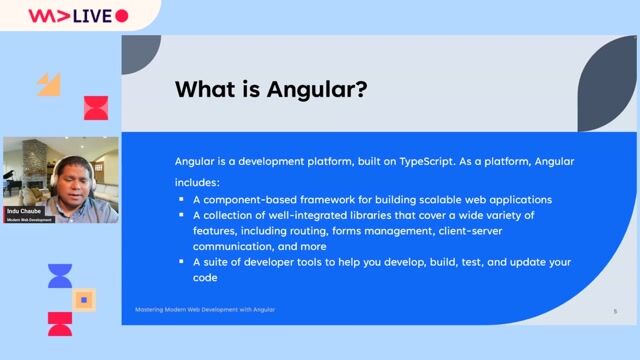Noam Honig
Meet Your New BFF: Backend to Frontend without the Duct Tape
#1about 4 minutes
The problem of repetitive code in full-stack development
Full-stack development often involves duplicating models, validation, and API logic, which can be streamlined by using a single source of truth.
#2about 5 minutes
Creating a full-stack API from a single entity definition
Use Remult decorators on a shared TypeScript class to automatically generate a full CRUD API with an Express server.
#3about 4 minutes
Connecting Angular to the API for CRUD operations
Use the Remult repository on the frontend to perform type-safe CRUD operations with built-in server-side paging, sorting, and filtering.
#4about 2 minutes
Enabling real-time data synchronization with live queries
Convert a standard data fetch into a real-time subscription by replacing `find` with `liveQuery` to automatically push updates to all connected clients.
#5about 2 minutes
Refactoring live queries with RxJS and the async pipe
Simplify component logic by converting the live query into an RxJS observable and using Angular's async pipe to manage subscriptions automatically.
#6about 2 minutes
Implementing write-once validation for frontend and backend
Define validation logic directly on the entity to enforce rules consistently on the client-side for immediate feedback and the server-side for security.
#7about 3 minutes
Optimizing operations with backend methods
Move inefficient client-side loops into a dedicated backend method to reduce network requests and execute business logic securely on the server.
#8about 1 minute
Switching from a JSON file to a Postgres database
Transition from the default JSON file storage to a production-ready Postgres database by simply configuring a data provider and connection string.
#9about 3 minutes
Securing the API with authentication and authorization
Secure API endpoints by adding rules like `allowAuthenticated` and role-based permissions directly to the entity definition.
#10about 2 minutes
Dynamically showing or hiding UI based on user permissions
Use the entity's metadata on the frontend to conditionally render UI elements, ensuring users only see actions they are permitted to perform.
#11about 5 minutes
Preparing and deploying the application to Railway
Configure the application for a production environment using environment variables and deploy it as a single server to a cloud provider like Railway.
#12about 3 minutes
Generating OpenAPI and GraphQL APIs from entities
Automatically generate both an OpenAPI (Swagger) specification and a GraphQL API from the existing Remult entities with minimal configuration.
#13about 16 minutes
Answering questions on Remult's capabilities and use cases
The speaker addresses audience questions about production readiness, scaling, framework compatibility, and best practices for reducing boilerplate code.
Related jobs
Jobs that call for the skills explored in this talk.
Apaleo
München, Germany
Remote
€65-85K
Senior
JavaScript
.NET
+2
Matching moments

03:28 MIN
Shifting from talent acquisition to talent architecture
The Future of HR Lies in AND – Not in OR

06:51 MIN
Balancing business, technology, and people for holistic success
The Future of HR Lies in AND – Not in OR

03:13 MIN
How AI can create more human moments in HR
The Future of HR Lies in AND – Not in OR

06:04 MIN
The importance of a fighting spirit to avoid complacency
The Future of HR Lies in AND – Not in OR

05:10 MIN
How the HR function has evolved over three decades
The Future of HR Lies in AND – Not in OR

06:59 MIN
Moving from 'or' to 'and' thinking in HR strategy
The Future of HR Lies in AND – Not in OR

04:22 MIN
Navigating ambiguity as a core HR competency
The Future of HR Lies in AND – Not in OR

06:10 MIN
Understanding global differences in work culture and motivation
The Future of HR Lies in AND – Not in OR
Featured Partners
Related Videos
 25:53
25:53Build and Deploy a Fullstack App with Open Source Tooling
Noam Honig
 35:17
35:17Front-End Micro Apps
Serg Hospodarets
 1:06:20
1:06:20WeAreDevelopers LIVE – Frontend Inspirations, Web Standards and more
Chris Heilmann, Daniel Cranney & Jan Deppisch
 40:24
40:24Snappy UI needs no Single-Page Application
Clemens Helm
 50:28
50:28Angular tips/tricks you can use from tomorrow on
Benedikt Starzengruber
 36:33
36:33Building Apps With a Mixture of Code and No Code
Mark Piller
 42:16
42:16Hello generics, goodbye boilerplate!
Miroslav Jonaš
 58:56
58:56Angular Unleashed: Mastering Modern Web Development with Angular
Indu Chaube
Related Articles
View all articles



From learning to earning
Jobs that call for the skills explored in this talk.


Top web
Remote
£145-187K
Intermediate
React
JavaScript
TypeScript

TechXperts Recruitment
York, United Kingdom
Remote
£45-60K
CSS
HTML
Azure
+4

Launchly Pro
Remote
£33K
API
REST
React
+3


Tenth Revolution
Barcelona, Spain
Intermediate
CSS
GIT
HTML
RxJS
DevOps
+3

engelhardt softwareentwicklung
Ditzingen, Germany
API
GIT
Angular
TypeScript

